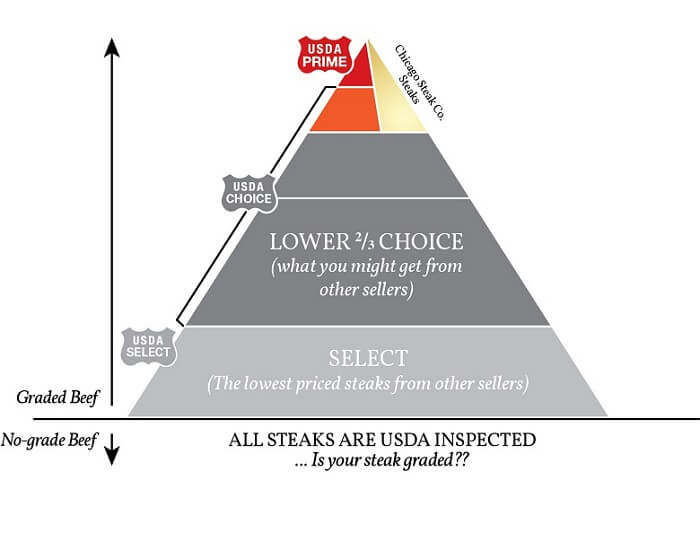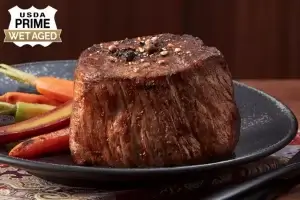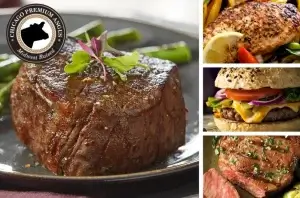
For steak lovers, suppliers, and farmers alike, the USDA’s beef grading system is the holy standard for all things beef, from ribeye to New York strip.
But for those unfamiliar with how beef is graded by the USDA, the different USDA steak grades and what they mean can be somewhat mystifying. It doesn’t help that certain restaurants, supermarkets, and suppliers are doing their best to confuse you so they can serve you inferior steaks.
To make sure you’re getting the best steak possible, it’s important that you understand how the USDA grading system works. With this guide, you’ll learn about the different grades of beef, including Prime grade beef, Choice grade beef, and Select grade beef. You’ll also learn what the USDA looks for when judging cattle, and why marbling and age are so important to quality cuts.
Table of Contents
What To Look For And Why
When purchasing steaks, always look for the USDA shield.
Crafty restaurants, supermarkets, and wholesalers might say that they use their own, in-house ratings, or will call their steaks “prime” cuts, without using USDA certification. The best way to avoid getting cheated on your steak is to look for the USDA seal.
For restaurants: Ask for the USDA rating. If your server skirts the topic, that’s a warning sign.
For supermarkets and wholesalers: Look for the USDA seal. If you cannot find it (it might be on the bottom of the package), the meat is not USDA certified.
USDA Beef Grades
The Upper Cuts: Prime, Choice, and Select
The USDA has eight grades for beef, but you will probably find only three labelled grades at your local supermarket or butcher shop. These are Prime grade beef, Choice grade beef, and Select grade beef.
- USDA PRIME steak is reserved for the best cuts of beef. Just 2% of steaks get labelled USDA Prime. Steaks of this quality grade are quickly bought by five-star restaurants and upscale wholesalers. Because of this, Prime steaks are rarely found in supermarkets or grocery stores. Prime cuts are sourced from younger steers, and are abundant in marbling and reddish-pink in color. They are the most tender, juicy, and flavorful steaks on the market.
- USDA CHOICE steak is the step below Prime. USDA Choice cuts are available in most grocery stores and medium-priced restaurants. A Choice steak often has the same reddish-pink color of a Prime cut, but lacks the same level of marbling. The amount of marbling found in Choice cuts can vary widely. It is wise to inspect a Choice steak to see how much marbling it contains. Depending on the cut, a Choice steak may require slower cooking or a marinade to bring out its tenderness, juiciness, and flavor.
- USDA SELECT steaks sit at the lower end of the quality cuts. Because of the low level of marbling found in Select cuts, they usually require marinating. Salt-rich or acidic sauces/marinades can also help tenderize Select steaks, as salt and acids soften and help to break down tougher tissues. Select steaks also benefit from longer cooking times at lower temperatures.
Grading Criteria: What Makes A Great Steak
USDA grades are based on what makes a steak as tender, juicy, and flavorful as possible. There are two main criteria that help graders determine which cattle produce the best beef.
Marbling, also known as “intramuscular fat,” is the most prized feature in steaks. Marbling is characterized by thin streaks of fat between muscle tissue. When cooked, the fat melts. This gives the meat unparalleled tenderness and a rich, buttery flavor.
Age is another important factor in steak quality. Younger steaks are more tender and flavorful than older cuts of meat. Because of this, most Prime and Choice steaks come from steers 1 to 3 years in age. Steak age is usually determined by the color of the meat, as steaks turn a deeper, darker color as they age.
The “Other” 5 USDA Beef Grades
The two medium grades – Standard and Commercial – result in lower quality cuts. For steaks, these cuts are usually left unlabeled, or get turned into ground beef. Many stores will sell unlabeled Standard or Commercial grade steaks under in-house labels, which is why it’s so important to keep an eye out for the USDA seal.
Cattle that receive one of the lowest three grades – Utility, Cutter, and Canner – are used for cheaper ground beef, hot dogs, or pet food. Luckily, steaks of this grade are rarely (if ever) sold by grocery stores, butchers, or wholesalers.
Any of the five lower grades should be avoided when purchasing steaks.
Prime Time: Grill Meets Grade
Now that you know how to find the best steaks, it’s time to put knowledge to practice. With a firm grasp of the USDA grading system, you’ll be able to find a wholesaler, butcher, or grocery store you can trust to deliver high-quality cuts. And remember: Grade-A steaks deserve a Grade-A recipe.



